As a beginner learning how to play piano, developing a strong foundation in piano scales is highly beneficial. Practicing scales helps familiarize yourself with the keyboard, improve finger dexterity, and gain an understanding of music theory concepts. In addition, scales greatly enhance ear training and serve as effective warm-up exercises to prepare your fingers for playing!
Advantages of learning piano scales
Specifically, learning and practicing piano scales as a beginner can offer the following advantages…
Technique Development: Scales help develop proper piano technique, including finger independence, coordination, and strength. Playing a sequence of notes using different fingers promotes dexterity and control over the keyboard.
Finger Placement and Accuracy: Scales provide an opportunity to practice accurate finger placement on the keys, improving hand position and precision. This precision translates to more accurate playing in other musical pieces.
Musical Understanding: Scales form the foundation of music theory, offering insights into key signatures, tonalities, and the structure of melodies and harmonies. Understanding scales is crucial for improvisation, composition, and effective interpretation of musical pieces.
Warm-up and Technical Exercises: Scales serve as excellent warm-up exercises before practice or performance. They loosen up the fingers, warm up the muscles, and prepare the mind for focused piano playing. Incorporating scale practice into your regular routine helps maintain and improve your piano playing technique.
So, embrace the journey of learning scales with enthusiasm! They might seem small, but they have a big impact on your piano skills. Get ready to enjoy the process and let the scales guide you towards becoming a confident and accomplished pianist!
Piano scales for beginners
We’ve included major scales, like C Major, G Major, D Major, and more, as they provide a solid understanding of tonalities and key signatures. Additionally, we incorporated minor scales, such as A minor, E minor, D minor, to introduce the concept of relative major and minor keys. Lastly, we included the chromatic scale, which allows beginners to practice all twelve pitches in an octave, further enhancing finger independence and coordination.
Here are the 10 must-learn piano scales for beginners, along with their descriptions, fingering patterns, and key information.
C Major piano scale
The C Major scale is the most basic scale and is often the first scale that beginners learn. It is played on the white keys of the piano, starting from C and going up one octave to the next C.
The right-hand fingering pattern for ascending is 1-2-3-1-2-3-4-5, and for descending is 5-4-3-2-1-3-2-1. The left-hand fingering pattern for ascending is 5-4-3-2-1-3-2-1, and for descending is 1-2-3-1-2-3-4-5.
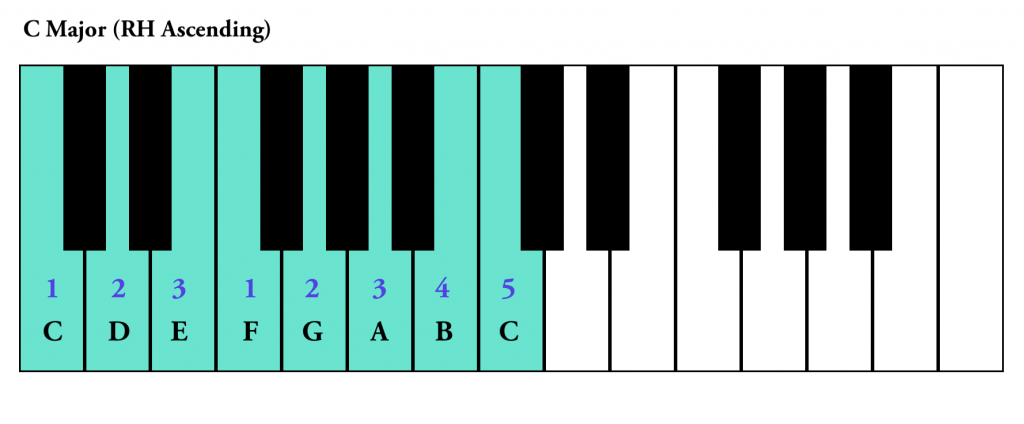
G Major piano scale
Introducing one sharp (F#), the G Major scale expands the range and challenges finger dexterity by incorporating a black key. It is played on both white and black keys, starting from G and going up one octave to the next G.
The right-hand fingering pattern for ascending is 1-2-3-1-2-3-4-5, and for descending is 5-4-3-2-1-3-2-1. The left-hand fingering pattern for ascending is 5-4-3-2-1-3-2-1, and for descending is 1-2-3-1-2-3-4-5.
Practicing the G Major scale helps develop further coordination and strengthens the understanding of key signatures.
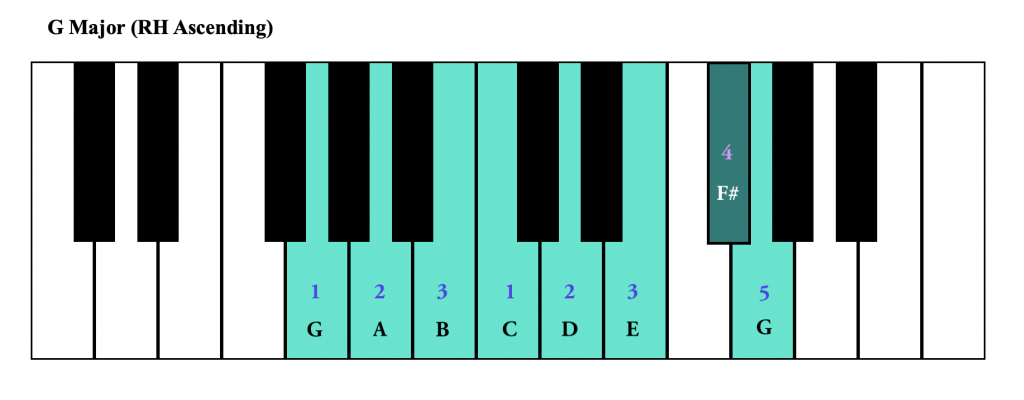
F Major piano scale
The F Major scale is played on the white keys, starting from F and going up one octave to the next F. It introduces one flat (Bb).
The right-hand fingering pattern for ascending is 1-2-3-4-1-2-3-4, and for descending is 4-3-2-1-4-3-2-1. The left-hand fingering pattern for ascending is 5-4-3-2-1-3-2-1, and for descending is 1-2-3-1-2-3-4-5.
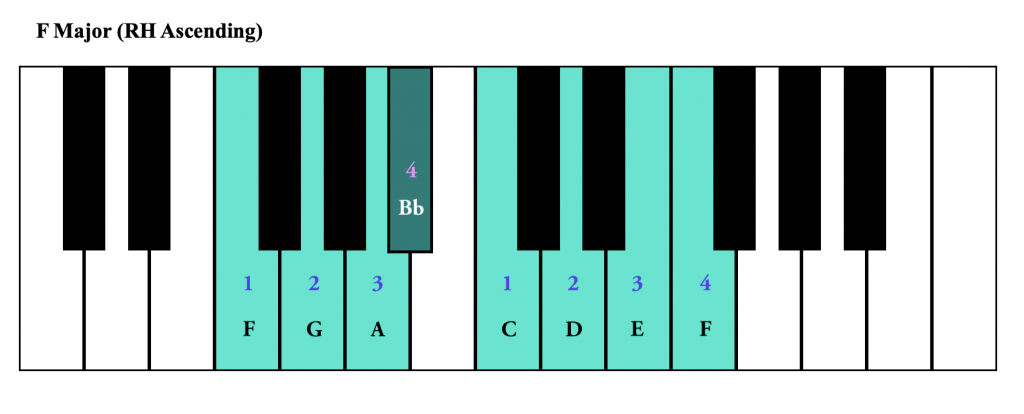
D Major piano scale
The D Major scale is played on both white and black keys, starting from D and going up one octave to the next D. It introduces two sharps (F# and C#).
The right-hand fingering pattern for ascending is 1-2-3-1-2-3-4-5, and for descending is 5-4-3-2-1-3-2-1. The left-hand fingering pattern for ascending is 5-4-3-2-1-3-2-1, and for descending is 1-2-3-1-2-3-4-5.
Mastering the D Major scale further enhances finger dexterity and increases your familiarity with playing scales in different key signatures.
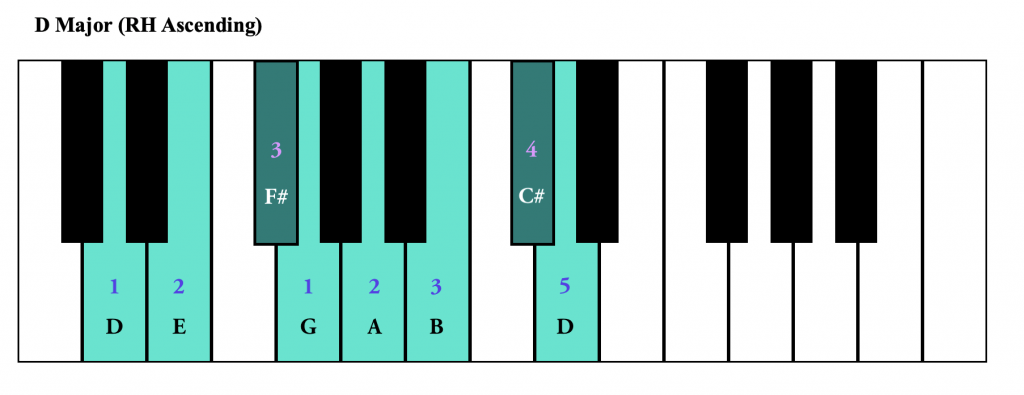
A minor piano scale
The A minor scale is played on both white and black keys, starting from A and going up one octave to the next A. It introduces no sharps or flats.
The right-hand fingering pattern for ascending is 1-2-3-1-2-3-4-5, and for descending is 5-4-3-2-1-3-2-1. The left-hand fingering pattern for ascending is 5-4-3-2-1-3-2-1, and for descending is 1-2-3-1-2-3-4-5.
Practicing the A Minor scale strengthens finger coordination and reinforces the understanding of playing in a minor tonality.
E Major piano scale
The E Major scale is played on both white and black keys, starting from E and going up one octave to the next E. It introduces four sharps (F#, C#, G#, and D#).
The right-hand fingering pattern for ascending is 1-2-3-1-2-3-4-5, and for descending is 5-4-3-2-1-3-2-1. The left-hand fingering pattern for ascending is 5-4-3-2-1-3-2-1, and for descending is 1-2-3-1-2-3-4-5.
Mastering the E Major scale challenges finger dexterity and strengthens the ability to navigate scales with multiple sharps.

D minor piano scale
The D Minor Scale is played on both white and black keys, starting from D and going up one octave to the next D. It introduces no sharps or flats.
The right-hand fingering pattern for ascending is 1-2-3-1-2-3-4-5, and for descending is 5-4-3-2-1-3-2-1. The left-hand fingering pattern for ascending is 5-4-3-2-1-3-2-1, and for descending is 1-2-3-1-2-3-4-5.
Practicing the D Minor scale helps develop finger coordination and provides an understanding of playing in a minor tonality.
A Major piano scale
The A Major scale is played on both white and black keys, starting from A and going up one octave to the next A. It introduces three sharps (F#, C#, and G#).
The right-hand fingering pattern for ascending is 1-2-3-1-2-3-4-5, and for descending is 5-4-3-2-1-3-2-1. The left-hand fingering pattern for ascending is 5-4-3-2-1-3-2-1, and for descending is 1-2-3-1-2-3-4-5.
Practicing the A Major scale strengthens finger coordination and reinforces the understanding of playing scales with multiple sharps.
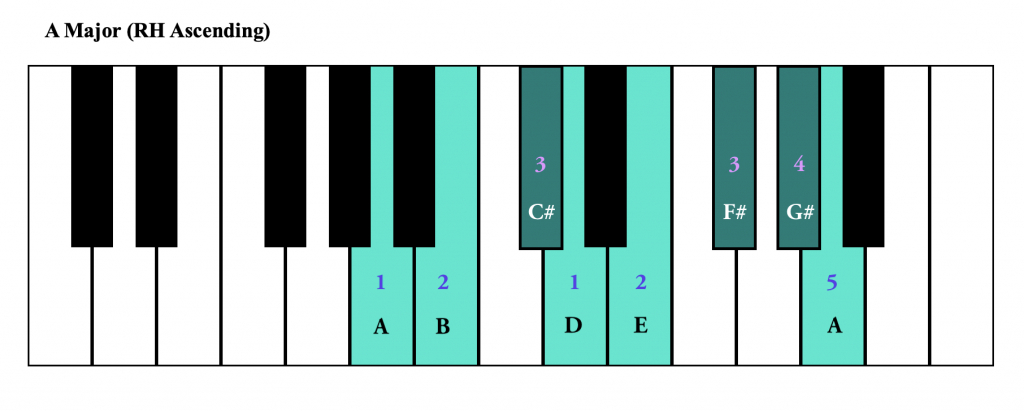
E minor piano scale
The E minor scale is played on both white and black keys, starting from E and going up one octave to the next E. It introduces no sharps or flats.
The right-hand fingering pattern for ascending is 1-2-3-1-2-3-4-5, and for descending is 5-4-3-2-1-3-2-1. The left-hand fingering pattern for ascending is 5-4-3-2-1-3-2-1, and for descending is 1-2-3-1-2-3-4-5.
Practicing the E Minor scale further develops finger coordination and provides a deeper understanding of playing in a minor tonality.
Chromatic scale
The Chromatic scale includes all twelve pitches in an octave, moving up or down in half steps (one key at a time). Play it with both hands, starting from C and going up or down to the next C.
The right-hand fingering pattern for ascending is 1-3-1-3 1-2-3 1-3-1-3 1-2, and for descending is 2-1 3-1-3-1 3-2-1 3-1-3-1. The left-hand fingering pattern for ascending is 1-3-1-3 2-1-3 1-3-1-3 2-1, and for descending is 1-2 3-1-3-1 3-1-2 3-1-3-1.
Practicing the Chromatic scale improves finger independence, coordination, and familiarity with all the keys on the piano.
Piano Scales: How to Learn and Practice Them
Remember, piano scales are not just a series of notes to practice. They are the building blocks of your piano journey, empowering you with technique, dexterity, and musical understanding. Embrace the journey of learning scales with enthusiasm, for they might seem small, but they have a big impact on your piano skills.
As you dive into these 10 essential scales, let the music flow through your fingers and feel the joy of progress. Each scale you conquer brings you closer to becoming a confident and accomplished pianist. So, get ready to enjoy the process, overcome challenges, and let the scales guide you towards your musical aspirations.
If you’d like to see a demo of each scale being played by a teacher, check out Playground Sessions’ step-by-step Scales Course. Not only will a teacher guide you through each scale, demonstrating proper fingerings, but Playground also breaks down each scale into several parts. This allows you to learn a scale in smaller chunks before gradually playing up and down the scale with both hands, reaching the ultimate destination. Sign up for a free 30-day trial and give it a shot!

